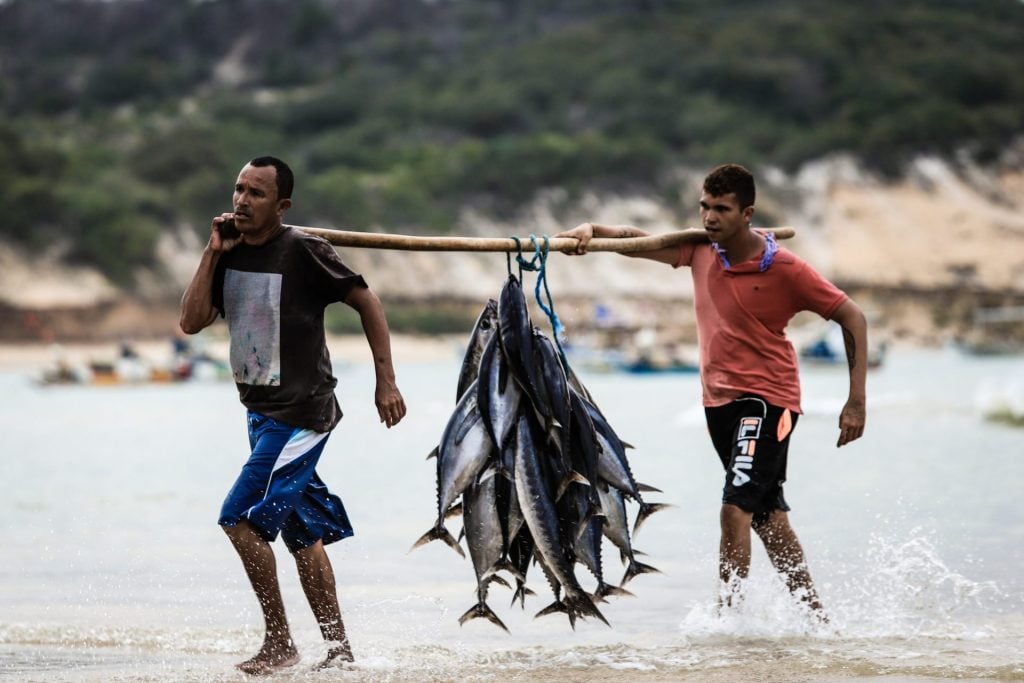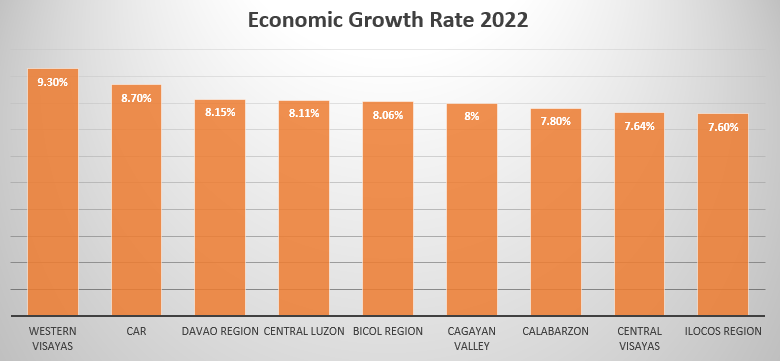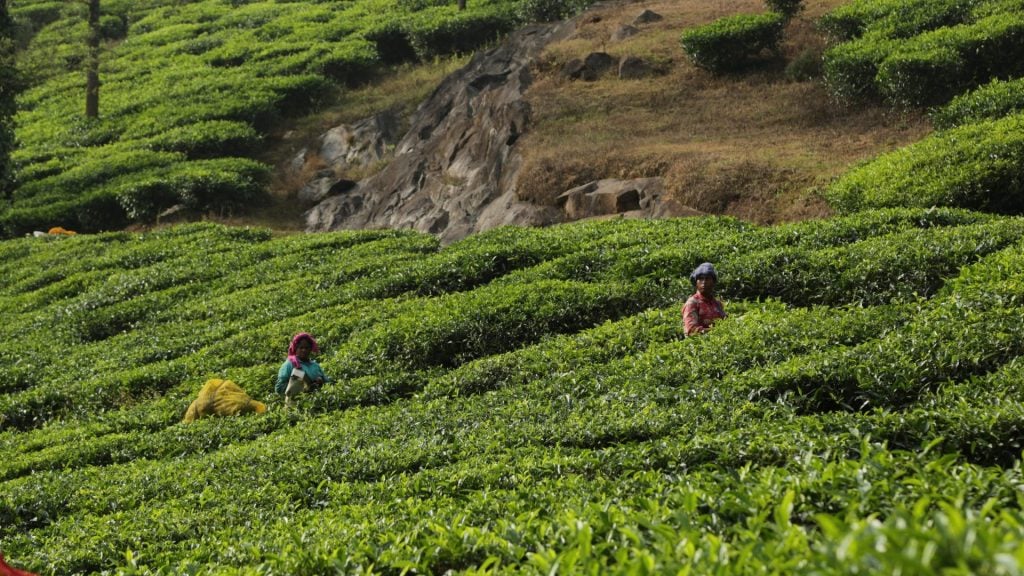BLOGS
17 Regions Showing Positive Growth in 2022
Learn about the top regions in the Philippines showing positive growth in 2022. From Western Visayas to SOCCSKSARGEN, we’ll explore these unique economies and cultures driving their growth. Join us as we discover the beauty and economic potential of these regions in the Philippines.
The Philippine economy is thriving like never before, and it’s showing up in the numbers.
The Philippine government’s proactive efforts to improve the business climate and attract more foreign investments have been instrumental in the country’s impressive economic growth. In 2022, the country experienced a significant increase of 7.6% compared to last year’s 5.7%, with all the major industries showing a positive bottom line.
The current administration has also adopted and strengthened the “Build, Build, Build” from the previous initiatives. It has allocated significant funds for building new roads, bridges, airports, and other infrastructure projects. These developments have improved the country’s transportation and communication systems, making it easier for businesses to operate and expand.
As we anticipate how will our economy perform this year, it’s worth taking a closer look at the regions across the Philippines experiencing positive growth. The economies of 17 regions are showing impressive progress and are worth watching as we move forward.

Top Performing Regions In The Philippines
The Philippine Statistics Authority (PSA) recently posted the fastest growth in the economic growth of different regions in the country, and the results are impressive. Western Visayas recorded the highest economic growth rate of 9.30% in 2019, followed by the Cordillera Administrative Region (CAR) with 8.70% and Davao Region with 8.15%. Other regions with impressive economic growth rates include Central Luzon, Bicol Region, Cagayan Valley, Calabarzon, Central Visayas, and Ilocos Region.
The growth is attributed to various factors, such as the thriving tourism industry, growth in the services sector, investments in infrastructure development, and growth in the agriculture, forestry, and fishing sectors.
Another report from PSA also shows that Western Visayas topped the regional economies in the country with an impressive per capita growth rate of 8.4 percent, followed by the Cordillera Administrative Region at 7.8 percent, Bicol Region at 7.1 percent, and Cagayan Valley at 7.0 percent.
Regarding industry performance, Food Service Activities have the fastest growth at 32.1%, followed by Other Services at 28.4% and Transportation and Storage at 23.9%. The increasing demand for food delivery, personal care, repair and maintenance services, transportation, and storage has led to the growth in this sector.
All Regions in the Philippines
Ilocos Region
The Ilocos region, or Region I, is located in the northwest part of Luzon and comprises four provinces: Ilocos Norte, Ilocos Sur, La Union, and Pangasinan. The region is known for its stunning beaches, historical landmarks, and delicious cuisine. The major industries in the region are agriculture, fisheries, and tourism. Ilocos is famous for its tobacco, corn, and rice production, as well as its salt and fish sauce production. The region is also home to popular tourist destinations such as Vigan, Laoag, and Pagudpud.
Cagayan Valley
Also known as Region II, this region is located in the northeastern part of Luzon and comprises five provinces: Batanes, Cagayan, Isabela, Nueva Vizcaya, and Quirino. The region is known for its rich biodiversity, stunning landscapes, and vibrant culture. The major industries in the region are agriculture, mining, and tourism. Cagayan Valley is known for its rice, corn, and tobacco production and mining of gold, copper, and limestone.

Central Luzon
Region III is located in the central part of Luzon and comprises seven provinces: Aurora, Bataan, Bulacan, Nueva Ecija, Pampanga, Tarlac, and Zambales. The region is known for its historical landmarks, delicious cuisine, and thriving economy. The major industries in the region include agriculture, manufacturing, and tourism. Central Luzon is known for its rice, sugarcane, and corn production, as well as its manufacturing of electronics, textiles, and food products.
CALABARZON
Region IV-A is located in the southern part of Luzon and comprises five provinces: Cavite, Laguna, Batangas, Rizal, and Quezon. The region is known for its stunning beaches, beautiful mountains, and rich history. The major industries in the region include manufacturing, services, and agriculture. CALABARZON is known for its manufacturing of electronics, automotive parts, and garments, as well as its rice, coconut, and coffee production.
MIMAROPA
Region IV-B is located in the southern part of Luzon and comprises five provinces: Occidental Mindoro, Oriental Mindoro, Marinduque, Romblon, and Palawan. The region is known for its pristine beaches, diverse marine life, and rich culture. The major industries in the region include agriculture, fisheries, and tourism. MIMAROPA is known for its production of rice, coconut, and mango.
Bicol Region
Also known as Region V, this region is located in the southeastern part of Luzon and comprises six provinces: Albay, Camarines Norte, Camarines Sur, Catanduanes, Masbate, and Sorsogon. The region is known for its majestic Mayon Volcano, spicy cuisine, and vibrant festivals. The major industries in the region include agriculture, fisheries, and tourism. Bicol is known for its production of rice, coconut, and abaca, as well as its fishing industry and tourism-related businesses.
Western Visayas
Also known as Region VI, this region is located in the western part of the Visayas and comprises six provinces: Aklan, Antique, Capiz, Guimaras, Iloilo, and Negros Occidental. The region is known for its stunning beaches, delicious cuisine, and rich culture. The major industries in the region include tourism, agriculture, and fisheries. Western Visayas is known for its production of sugarcane, rice, and seafood, as well as its tourism-related businesses.
Central Visayas
Also known as Region VII, this region is located in the central part of the Visayas and comprises four provinces: Bohol, Cebu, Negros Oriental, and Siquijor. The region is known for its beautiful beaches, historic landmarks, and vibrant festivals. The major industries in the region include tourism, manufacturing, and agriculture. Central Visayas is known for its manufacturing of furniture, fashion accessories, and processed food products, as well as its sugarcane, coconut, and rice production.
Eastern Visayas
Also known as Region VIII, this region is located in the eastern part of the Visayas and is composed of six provinces: Biliran, Eastern Samar, Leyte, Northern Samar, Samar, and Southern Leyte. The region is known for its stunning beaches, natural wonders, and rich culture. The major industries in the region include agriculture, fisheries, and tourism. Eastern Visayas is known for its rice, coconut, and abaca production, as well as its fishing industry and tourism-related businesses.

Zamboanga Peninsula
Also known as Region IX, this region is located in the western part of Mindanao and is composed of three provinces: Zamboanga del Norte, Zamboanga del Sur, and Zamboanga Sibugay. The region is known for its stunning beaches, diverse culture, and delicious cuisine. The major industries in the region include agriculture, fisheries, and tourism. Zamboanga Peninsula is known for its rice, rubber, and seaweed production, as well as its fishing industry and tourism-related businesses.
Northern Mindanao
Also known as Region X, this region is located in the northern part of Mindanao and comprises five provinces: Bukidnon, Camiguin, Lanao del Norte, Misamis Occidental, and Misamis Oriental. The region is known for its stunning landscapes, diverse culture, and vibrant festivals. The major industries in the region include agriculture, manufacturing, and tourism. Northern Mindanao is known for its production of rice, corn, and sugarcane, as well as its manufacturing of processed food products, furniture, and garments.
Davao Region
Also known as Region XI, this region is located in the southeastern part of Mindanao and comprises four provinces: Davao del Norte, Davao del Sur, Davao Oriental, and Davao Occidental. The region is known for its beautiful landscapes, diverse culture, and delicious cuisine. The major industries in the region include agriculture, mining, and tourism. Davao Region is known for its production of banana, coconut, and durian, as well as its mining of gold, copper, and nickel. Brittany Corporation caters to the Davaoeños with its luxury condominiums and world-class luxury real estate.
SOCCSKSARGEN
Also known as Region XII, this region is located in the southern part of Mindanao and comprises four provinces: Cotabato, Sarangani, South Cotabato, and Sultan Kudarat. The region is known for its stunning landscapes, diverse culture, and delicious cuisine. The major industries in the region include agriculture, mining, and tourism. SOCCSKSARGEN is known for its rice, corn, and rubber production and mining of gold, copper, and chromite.
CARAGA
Also known as Region XIII, this region is located in the northeastern part of Mindanao and is composed of five provinces: Agusan del Norte, Agusan del Sur, Dinagat Islands, Surigao del Norte, and Surigao del Sur. The region is known for its pristine beaches, diverse culture, and rich biodiversity. The major industries in the region include agriculture, mining, and tourism. Caraga is known for its production of rice, corn, and coconut, as well as its mining of gold, nickel, and chromite.
Bangsamoro Autonomous Region in Muslim Mindanao (BARMM)
Also known as BARMM, this region is located in the southern part of Mindanao and comprises five provinces: Basilan, Lanao del Sur, Maguindanao, Sulu, and Tawi-Tawi. The region is known for its rich culture, stunning landscapes, and vibrant festivals. The major industries in the region include agriculture, fisheries, and tourism. BARMM is known for its rice, corn, and seaweed production, as well as its fishing industry and tourism-related businesses.

Cordillera Administrative Region (CAR)
Also known as CAR, this region is located in the northern part of Luzon and comprises six provinces: Abra, Apayao, Benguet, Ifugao, Kalinga, and Mountain Province. The region is known for its stunning landscapes, rich culture, and vibrant festivals. The major industries in the region include agriculture, mining, and tourism. Here you can find the beautiful City of Pines, where you can enjoy luxury condo such as Bern to experience Brittany Living.
National Capital Region (NCR)
Also known as Metro Manila, this region is located in the central part of Luzon and comprises 16 cities and one municipality. The region is known for its bustling economy, rich history, and vibrant culture. The major industries in the region include services, manufacturing, and finance. Metro Manila is known for its service-related businesses, manufacturing of electronics and garments, and finance-related businesses.
Final Thoughts
The Philippines boasts a rich diversity of regions, each with unique strengths and potential for growth. The fact that all 17 regions recorded positive growth in 2022 is a testament to the country’s concerted efforts toward consistent economic development and recovery.
By leveraging the strengths and potential of each region, the Philippines is poised for sustained growth and prosperity. The future looks bright for the country and its people, and we can anticipate even greater achievements in the coming years.
all regions in the Philippines
The Philippines is divided into 17 regions, each with its unique culture, history, and economy. These regions range from the bustling National Capital Region to the scenic Cordillera Administrative Region and the beautiful beaches of Central Visayas.
regions with positive growth in 2022
According to the Regional Accounts of the Philippines report by the Philippine Statistics Authority, all 17 regions recorded positive growth in 2022. Western Visayas had the fastest growth rate at 9.3%, followed by Cordillera Administrative Region (CAR) at 8.7% and Davao Region at 8.15%. Other regions with growth rates above the national level were Central Luzon, MIMAROPA, CALABARZON, and SOCCSKSARGEN.
Suggested Read: Major Dialects That Enrich The Filipino Language
Suggested Read: Davao Regional Development Plan 2023-2028
Suggested Read: Metro Manila Cost Of Living Remains Stable
Suggested Read: Why Seafood Feasts Are Popular In Davao
Suggested Read: Economic Effect Of Hybrid Rice
















